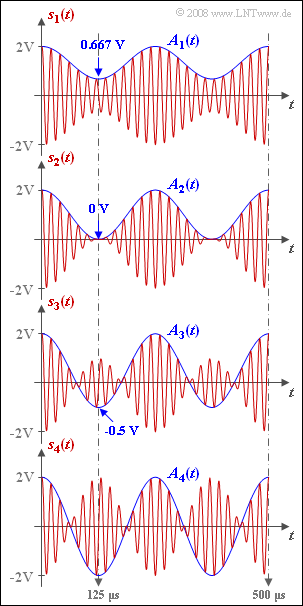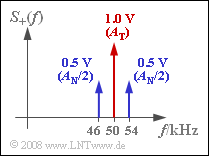Difference between revisions of "Aufgaben:Exercise 2.2: Modulation Depth"
m |
m |
||
| Line 4: | Line 4: | ||
[[File:P_ID989__Mod_A_2_2.png|right|frame|Modulationsgrad-Definition bei ZSB–AM]] | [[File:P_ID989__Mod_A_2_2.png|right|frame|Modulationsgrad-Definition bei ZSB–AM]] | ||
| − | The graph shows DSB- | + | The graph shows DSB amplitude-modulated signals $s_1(t)$ to $s_4(t)$ with differing modulation depth $m$. Let message signal $q(t)$ and carrier signal $z(t)$ each be cosine: |
:$$q(t) = A_{\rm N} \cdot \cos (2 \pi f_{\rm N} t),\hspace{0.2cm} f_{\rm N} = 4\,{\rm kHz}\hspace{0.05cm},$$ | :$$q(t) = A_{\rm N} \cdot \cos (2 \pi f_{\rm N} t),\hspace{0.2cm} f_{\rm N} = 4\,{\rm kHz}\hspace{0.05cm},$$ | ||
:$$ z(t) = \hspace{0.2cm}1 \hspace{0.15cm} \cdot \cos (2 \pi f_{\rm T} t),\hspace{0.2cm} f_{\rm T} = 50\,{\rm kHz}\hspace{0.05cm}.$$ | :$$ z(t) = \hspace{0.2cm}1 \hspace{0.15cm} \cdot \cos (2 \pi f_{\rm T} t),\hspace{0.2cm} f_{\rm T} = 50\,{\rm kHz}\hspace{0.05cm}.$$ | ||
| Line 11: | Line 11: | ||
In the graphs, the chosen normalization was: | In the graphs, the chosen normalization was: | ||
:$$A_{\rm T}+ A_{\rm N} = 2\,{\rm V}\hspace{0.05cm}.$$ | :$$A_{\rm T}+ A_{\rm N} = 2\,{\rm V}\hspace{0.05cm}.$$ | ||
| − | * | + | *If the modulation depth is $m ≤ 1$, then $A(t)= q(t) + A_{\rm T}$ is equal to the envelope $a(t)$. |
*In contrast, for a modulation depth $m > 1$: | *In contrast, for a modulation depth $m > 1$: | ||
:$$a(t ) = |A(t)|\hspace{0.05cm}.$$ | :$$a(t ) = |A(t)|\hspace{0.05cm}.$$ | ||
| Line 47: | Line 47: | ||
{Which statements are true for the signal $s_4(t)$ ? | {Which statements are true for the signal $s_4(t)$ ? | ||
|type="[]"} | |type="[]"} | ||
| − | + | + | + This is a case of "DSB–AM without a carrier". |
| − | - | + | - The modulation depth is $m = 0$. |
| − | + | + | + The modulation depth $m$ is infinite. |
| − | { | + | {Let $A_{\rm T} = A_{\rm N} = 1\ \rm V$, so $m = 1$. What is the spectrum $S_+(f)$ of the analytical signal? <br>Which Dirac weights occur at $f_{\rm T}$ as well as at $f_{\rm T}± f_{\rm N}$ ? |
|type="{}"} | |type="{}"} | ||
$S_+(f_{\rm T}) \ = \ $ { 1 3% } $\ \text{V}$ | $S_+(f_{\rm T}) \ = \ $ { 1 3% } $\ \text{V}$ | ||
$S_+(f_{\rm T} ± f_{\rm N}) \ = \ $ { 0.5 3% } $\ \text{V}$ | $S_+(f_{\rm T} ± f_{\rm N}) \ = \ $ { 0.5 3% } $\ \text{V}$ | ||
| − | { | + | {Now let $m = 1$. Which fraction $P_{\rm T}/P_{\rm S}$ of the total transmission power $P_{\rm S}$ is due to the carrier alone, and thus cannot be used for demodulation?? |
|type="{}"} | |type="{}"} | ||
$P_{\rm T}/P_{\rm S} \ = \ $ { 0.667 3% } | $P_{\rm T}/P_{\rm S} \ = \ $ { 0.667 3% } | ||
| − | { | + | {Generalize the result from '''(4)''' for an arbitrary modulation depth $m$. <br>What are the power ratios for $m = 0.5$, $m = 3$ and $m → ∞$ ? |
|type="{}"} | |type="{}"} | ||
$m = 0.5\text{:}\hspace{0.3cm} P_{\rm T}/P_{\rm S} \ = \ $ { 0.889 3% } | $m = 0.5\text{:}\hspace{0.3cm} P_{\rm T}/P_{\rm S} \ = \ $ { 0.889 3% } | ||
| Line 67: | Line 67: | ||
$m → ∞ \text{:}\hspace{0.3cm} P_{\rm T}/P_{\rm S} \ = \ $ { 0. } | $m → ∞ \text{:}\hspace{0.3cm} P_{\rm T}/P_{\rm S} \ = \ $ { 0. } | ||
| − | { | + | {Based on the calculations so far, which of the following assessments seem reasonable to you? |
|type="[]"} | |type="[]"} | ||
| − | + $m ≈ 1$ | + | + $m ≈ 1$ s more favorable than a small $m$ for energy reasons. |
| − | + | + | + The carrier is only useful for envelope demodulation. |
</quiz> | </quiz> | ||
| Line 88: | Line 88: | ||
| − | '''(2)''' | + | '''(2)''' <u>Answers 1 and 3</u> are correct: |
*In diesem Fall ist $A_{\rm T} = 0$, das heißt, es liegt tatsächlich eine „ZSB–AM ohne Träger” vor. | *In diesem Fall ist $A_{\rm T} = 0$, das heißt, es liegt tatsächlich eine „ZSB–AM ohne Träger” vor. | ||
*Der Modulationsgrad $m = A_{\rm N}/A_{\rm T}$ ist unendlich groß. | *Der Modulationsgrad $m = A_{\rm N}/A_{\rm T}$ ist unendlich groß. | ||
Revision as of 12:48, 24 November 2021
The graph shows DSB amplitude-modulated signals $s_1(t)$ to $s_4(t)$ with differing modulation depth $m$. Let message signal $q(t)$ and carrier signal $z(t)$ each be cosine:
- $$q(t) = A_{\rm N} \cdot \cos (2 \pi f_{\rm N} t),\hspace{0.2cm} f_{\rm N} = 4\,{\rm kHz}\hspace{0.05cm},$$
- $$ z(t) = \hspace{0.2cm}1 \hspace{0.15cm} \cdot \cos (2 \pi f_{\rm T} t),\hspace{0.2cm} f_{\rm T} = 50\,{\rm kHz}\hspace{0.05cm}.$$
The modulated signal (transmitted signal) with the DC component added in the modulator is $A_{\rm T}$:
- $$s(t ) = A(t) \cdot z(t), \hspace{0.2cm} A(t) = q(t) + A_{\rm T}\hspace{0.05cm}.$$
In the graphs, the chosen normalization was:
- $$A_{\rm T}+ A_{\rm N} = 2\,{\rm V}\hspace{0.05cm}.$$
- If the modulation depth is $m ≤ 1$, then $A(t)= q(t) + A_{\rm T}$ is equal to the envelope $a(t)$.
- In contrast, for a modulation depth $m > 1$:
- $$a(t ) = |A(t)|\hspace{0.05cm}.$$
- The cosine curve $A(t)$ varies between $A_{\rm max}$ and $A_{\rm min}$; because of normalization, $A_{\rm max} = 2 \ \rm V$ is always the case.
- The minimum values of $A(t)$ occur at half the period of the source signal $($i.e., for $t = 125 \ \rm µ s)$ :
- $$A_{\rm min} = q(T_0/2)+ A_{\rm T} = A_{\rm T}-A_{\rm N}.$$
- The numerical values are given in the graph.
Hints:
- This exercise belongs to the chapter Double-Sideband Amplitude Modulation.
- Particular reference is made to the page DSB-AM with carrier.
Questions
Solution
- $$ A_{\rm max} = A_{\rm T}+A_{\rm N}=2\,\,{\rm V},\hspace{0.3cm} A_{\rm min} = A_{\rm T}-A_{\rm N}\hspace{0.05cm}$$
directly follows:
- $$A_{\rm N} = (A_{\rm max} - A_{\rm min})/2,\hspace{0.3cm} A_{\rm T} = (A_{\rm max} + A_{\rm min})/2\hspace{0.05cm}.$$
- Thus, the modulation depth is
- $$m = \frac{A_{\rm max} - A_{\rm min}}{A_{\rm max} + A_{\rm min}}\hspace{0.05cm}.$$
- With the given numerical values, one obtains:
$$ m_1 = \frac{2\,{\rm V} - 0.667\,{\rm V}}{2\,{\rm V} + 0.667\,{\rm V}} \hspace{0.15cm}\underline {= 0.5}\hspace{0.05cm}, \hspace{0.5cm} m_2 = \frac{2\,{\rm V} - 0\,{\rm V}}{2\,{\rm V} + 0\,{\rm V}} \hspace{0.15cm}\underline {= 1.0}\hspace{0.05cm}, \hspace{0.5cm} m_3 = \frac{2\,{\rm V} -(-1\,{\rm V})}{2\,{\rm V} + (-1\,{\rm V})} \hspace{0.15cm}\underline{=3.0}\hspace{0.05cm}.$$
(2) Answers 1 and 3 are correct:
- In diesem Fall ist $A_{\rm T} = 0$, das heißt, es liegt tatsächlich eine „ZSB–AM ohne Träger” vor.
- Der Modulationsgrad $m = A_{\rm N}/A_{\rm T}$ ist unendlich groß.
(3) Das Spektrum $S_+(f)$ setzt sich für jeden Modulationsgrad $m$ aus drei Diraclinien zusammen mit folgenden Gewichten:
- $A_{\rm T}$ $($bei $f = f_{\rm T})$,
- $m/2 · A_{\rm T}$ $($bei $f = f_{\rm T} ± f_{\rm N})$.
Für $m = 1$ ergeben sich die Gewichte entsprechend der Skizze:
- $S_+(f_{\rm T}) = 1\ \rm V$,
- $S_+(f_{\rm T} ± f_{\rm T}) = 0.5\ \rm V$.
(4) Die auf den Widerstand $1 \ Ω$ bezogene Leistung (Quadrat des Effektivwertes) einer harmonischen Schwingung mit der Amplitude $A_{\rm T} = 1 \ \rm V$ beträgt:
- $$P_{\rm T} ={A_{\rm T}^2}/{2} = 0.5\,{\rm V}^2 \hspace{0.05cm}.$$
- In gleicher Weise erhält man für die Leistungen des unteren und des oberen Seitenbandes:
- $$P_{\rm USB} = P_{\rm OSB} =({A_{\rm N}}/{2})^2/2 = 0.125\,{\rm V}^2 \hspace{0.05cm}.$$
- Das gesuchte Verhältnis ist somit für $m=1$:
- $${P_{\rm T}}/{P_{\rm S}}= \frac{P_{\rm T}}{P_{\rm USB} + P_{\rm T}+ P_{\rm OSB}}= \frac{0.5\,{\rm V}^2}{0.125\,{\rm V}^2 + 0.5\,{\rm V}^2+ 0.125\,{\rm V}^2}= 2/3\hspace{0.15cm}\underline { = 0.667}\hspace{0.05cm}.$$
(5) Mit den Diracgewichten $m/2 · A_{\rm T}$ der beiden Seitenbänder entsprechend der Teilaufgabe (3) erhält man:
- $${P_{\rm T}}/{P_{\rm S}}= \frac{A_{\rm T}^2/2}{A_{\rm T}^2/2 + 2 \cdot (m/2)^2 \cdot A_{\rm T}^2/2}= \frac{2}{2 + m^2}\hspace{0.05cm}.$$
- Dies führt zu den Zahlenwerten $8/9 = 0.889$ $($für $m = 0.5)$, $2/11 = 0.182$ $($für $m = 3)$ und $0$ $($für $m \to ∞$).
(6) Beide Aussagen treffen zu:
- Die Zusetzung des Trägers macht nur Sinn, um den einfacheren Hüllkurvendemodulator verwenden zu können. Dies geht nur für $m \le 1$.
- Ist dagegen der Modulationsgrad $m > 1$ und somit der Einsatz eines Synchrondemodulators erforderlich, sollte man aus energetischen Gründen auf den Träger (fast) ganz verzichten.
- Ebenso ist bei Anwendung eines Hüllkurvendemodulators aus energetischen Gründen ein möglichst großer Modulationsgrad $m < 1$ ⇒ $m \to 1$ anzustreben.
- Allerdings kann durch einen kleinen Restträger die Trägerrückgewinnung erleichtert werden, die beim Synchrondemodulator zur Frequenz– und Phasensynchronisation benötigt wird. Die zweite Aussage ist somit nur bedingt als richtig zu bewerten.

